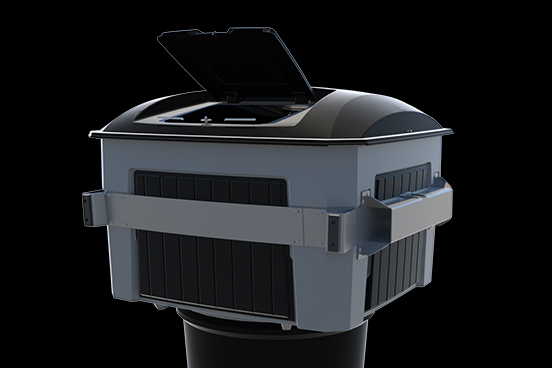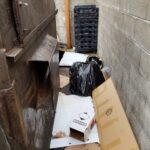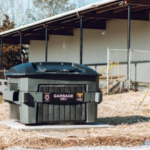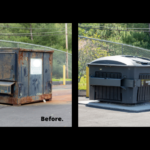Cities Are Finally Solving Solid Waste Containment…Clean In Plain Sight
For over 30 years, most major metro areas have tried to hide their biggest site planning problem…solid waste! Unsightly, smelly, surrounded with garbage, and oozing bacteria-laden leachate into the environment… dumpsters and their surroundings have bedeviled municipalities since the 1950’s, when post-war expansion led to a rapid growth of suburban communities.
Most municipalities have responded with strict zoning requirements for enclosures, waste walls, gated surrounds, and in some cases, waste rooms which are a part of a facility. Many such ordinances start out somewhat like this: “Refuse collection, dumpsters, recycling bins, and refuse handling areas shall be screened with a walled enclosure with gates in accordance with the standards in this subsection, etc.”[i] As the problem has grown, cities have thrown even more requirements at this challenge: opaque gates, dumpster pad drains, covered enclosures, earthen berms, masonry surrounds, architectural elements, and more.
Not one of these so-called solutions address the root issues at stake, and many only exacerbate them. Resolving municipal enclosure guidelines are also expensive, with average costs ranging from $18,000 to over $40,000[ii] to satisfy the demands of metropolitan planning boards and professionals. Even with all this, many property managers complain of trash buildup, vermin, almost overpowering odor, and even violent crimes in these secluded areas found behind facilities and out of the reach of security cameras. Most require driver egress to open gates, increasing safety issues.
The emergence of new solid waste technology, Subsurface Waste Containment, is resolving all this in many metro areas. Subsurface waste containment has been around for decades in Europe but is brand new in North America. Because it solves every issue which standard dumpsters and enclosures create, and saves thousands of dollars in cost, many metro areas are now changing their antiquated enclosure code requirements and embracing this new technology.
Subsurface waste containment works on three simple principles: easy access, easy dumping, and the basic laws of physics. Each container is constructed with a high-durability polyethylene body, the upper portion of which sits much lower than a standard dumpster, allowing anyone, including handicapped and senior citizens, to access either of the front or back feed doors. These doors always remain closed and are designed to reduce odor by up to 90% compared to a conventional steel dumpster.
Under each container is a large polyethylene “hold”, which fits into a simple cone-shaped sleeve which is pre-installed and anchored underground, ensuring that the containers are always placed back in the exact same location. This underground “hold” not only allows much greater capacity, but stores waste below the surface in cooler temperatures, greatly reducing odors and bacteria growth. Dumping these new containers is also simple and works well with any standard front-load (FEL) truck, and by design, is 70% quieter than metal dumpsters.
With subsurface containment, the entire container cannot rust and is completely sealed, so allows no leachate or waste ooze to escape the container. In addition to being far more sanitary, this also eliminates the need for dumpster drains or hosing stations within enclosures, a considerable savings for end users. This is a big issue with businesses and restaurants in close proximity to pedestrians or tourism areas, or near sensitive waterways.
Because subsurface containers are attractive, don’t leak, and reduce odors by 90% or more, they can be placed in areas close to consumers, previously unthinkable for dumpsters. Parking lot islands, landscaped areas, and corners or irregular areas of a property all work, and typically allow a site planner 1-3 additional parking spaces for the planning process, a critical addition on expensive city-center sites.
Many architects, designers, and metro planners have quickly adopted this new technology, realizing it removes all of the old obstacles in solid waste planning. Likewise, major cities are now also changing their enclosure codes to allow subsurface waste containment. A wide range of users are embracing the value in this new way to handle waste: retail shopping, commercial, low-rise family and student housing, parks, restaurants, universities, and many more. All have realized one thing: surrounding solid waste only makes the problem worse. The solution, better containment, odor and vermin control, easy access, and storing part of it below ground…was hiding in plain sight.
[i] Franklin, Tennessee Zoning Ordinance Document; p 256 /416
[ii] Interview with Fiser Company, August 12th 2019
Recent Articles

Unwanted Results – Solid Waste and Restaurants
What is the best way to handle solid waste (trash)

Trash Enclosure Challenges
The Unintended Consequences of Trash Enclosures Should we continue to











